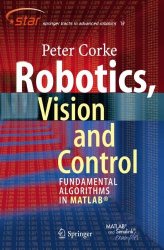Engineering Bookshelf
- Aerospace
- Biological
- Civil
- Chemical
- Environmental
- Electrical
- Materials
- Mechanical
- Petroleum
- Geoengineering
- Software

Robotics, Vision and Control: Fundamental Algorithms in MATLAB
by Peter CorkePublisher: Springer
ISBN: 3642201431
Check price @ amazon.com , amazon.ca , amazon.co.uk
Book Description
The practice of robotics and computer vision both involve the application of computational algorithms to data. Over the fairly recent history of the fields of robotics and computer vision a very large body of algorithms has been developed. However this body of knowledge is something of a barrier for anybody entering the field, or even looking to see if they want to enter the field — What is the right algorithm for a particular problem?, and importantly, How can I try it out without spending days coding and debugging it from the original research papers?
The author has maintained two open-source MATLAB Toolboxes for more than 10 years: one for robotics and one for vision. The key strength of the Toolboxes provide a set of tools that allow the user to work with real problems, not trivial examples. For the student the book makes the algorithms accessible, the Toolbox code can be read to gain understanding, and the examples illustrate how it can be used —instant gratification in just a couple of lines of MATLAB code. The code can also be the starting point for new work, for researchers or students, by writing programs based on Toolbox functions, or modifying the Toolbox code itself.
The purpose of this book is to expand on the tutorial material provided with the toolboxes, add many more examples, and to weave this into a narrative that covers robotics and computer vision separately and together. The author shows how complex problems can be decomposed and solved using just a few simple lines of code, and hopefully to inspire up and coming researchers. The topics covered are guided by the real problems observed over many years as a practitioner of both robotics and computer vision. It is written in a light but informative style, it is easy to read and absorb, and includes a lot of Matlab examples and figures. The book is a real walk through the fundamentals of robot kinematics, dynamics and joint level control, then camera models, image processing, feature extraction and epipolar geometry, and bring it all together in a visual servo system.
Book Review
“Good reading for starters in the field, but also for experienced researchers or practitioners. It is a pleasure to go through this book. It is written like an encyclopedia about robotics and computer vision … also, throughout the entire manuscript one can find the Matlab code for testing the presented theory. The author is also the creator of the two Matlab toolboxes robotics and machine vision, so there is probably no better way to understand and follow the topics than from the current book.” (Catalin Stoean, Zentralblatt MATH, Vol. 1233, 2012)
Customer Reviews
By dmvrlv
Pretty much covers all the essentials for programming / control of robots in conjunction with vision systems. Not limited to conventional 6 dof, coordinate based systems. In conjunction with the Matlab tool boxes provided, is an outstanding asset for developing complex robotic / vision systems.
By S
Many texts and academic papers on robotics are either too theory oriented that they neglect the details of implementation (e.g. giving continuous formulas when there are relevant details omitted for the discrete implementation), or written at too high/abstract a level to do an effective implementation. This text is different. It first walks through the required background necessary to understand the theory and the algorithms. Then it gives interesting examples on how to explore the problem further in MATLAB. This is really a key point for undergraduate or early graduate students. By giving the reader just enough to explore the problem further in MATLAB (and even teaches you how to animate in MATLAB to visualize and simulate dynamics), the proactive student will be able to master both the theory and the implementation, and study the author's software in the toolboxes in context.
In addition to the content, the binding of this book is really well made. It feels like it is worth the money you have paid. Although it is a paperback, perhaps it should become a new standard style in publishing (while we are still fortunate enough to have hard copies of books). It is much lighter than the typical hardback textbook, yet the cover is durable with a plastic coating. This book is full of rich, full color diagrams, and the price of the book is an anomaly among engineering texts these days (even among Springer texts). I am impressed with the detail of the content for implementation, theory, and practical considerations and look forward to keeping this as a reference.